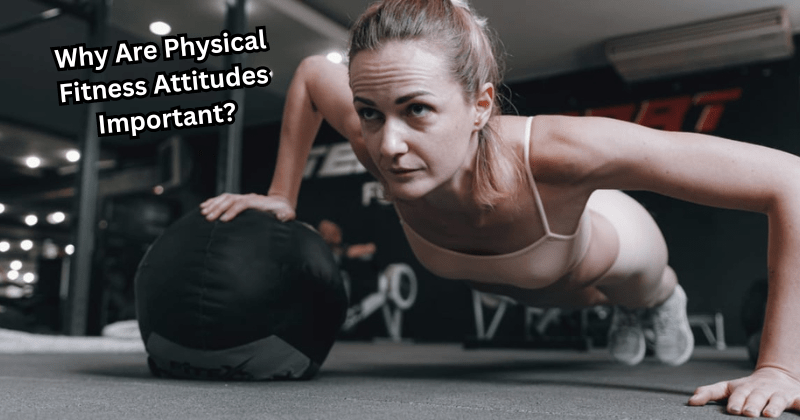Why are physical fitness attitudes important? They shape how we approach exercise and our overall health. Having a positive attitude towards fitness increases motivation to stay active, which boosts physical and mental health.
On the other hand, negative attitudes can lead to inactivity and poor health outcomes. This article delves into the significance of physical fitness attitudes and how they affect our daily lives.
Key Takeaways
- Positive attitudes toward physical fitness significantly enhance motivation, promote healthy behaviors, and improve physical and mental health.
- Negative attitudes towards physical fitness can deter regular physical activity, leading to sedentary lifestyles and associated health risks.
- Social cognitive theory highlights the role of self-efficacy and environmental factors in shaping physical fitness attitudes and behaviors, emphasizing the importance of supportive surroundings and successful role models.
Understanding Physical Fitness Attitudes
Our attitude towards physical fitness shapes not only how we approach exercise but also how we perceive our capabilities and overall well-being. Physical fitness attitudes are influenced by a way of thinking that encompasses our beliefs and feelings about the importance and benefits of exercise. These attitudes can significantly impact a person’s physical activity, motivation, and emotional well-being. They affect how we feel about ourselves, our environment, and our health.
Physical fitness attitudes are not static; they can evolve due to various factors such as life experiences, social influences, and personal milestones.
Understanding these attitudes is crucial because they play a pivotal role in determining whether we adopt healthy behaviors or succumb to sedentary lifestyles. Monitoring one’s body mass index can be an essential aspect of maintaining physical fitness and making informed decisions about adopting healthy behaviors.
Definition of Physical Fitness Attitudes
Physical fitness attitudes encompass beliefs about the importance and benefits of exercise, as well as the perceived value of maintaining fitness. These beliefs often include ideas about how exercise contributes to health, longevity, and quality of life. Our feelings towards physical activity range from enjoyment and satisfaction to reluctance and discomfort.
Positive feelings encourage consistent participation, while negative feelings can deter us from being active.
Impact on Behavior
A positive attitude towards physical fitness can impact our mindset, encouraging us to be more active. This positive outlook can also influence our behavior, making us more likely to engage in physical activity. When we believe in the benefits of exercise and enjoy the process, we’re more likely to engage in regular physical activity. This mindset fosters healthy habits, such as consistent exercise routines and a balanced diet, essential for maintaining a healthy lifestyle.
On the other hand, negative attitudes can lead to sedentary behavior, which poses significant health risks. Developing healthy habits is an ongoing process that requires motivation and a positive outlook. By understanding the impact of our attitudes on behavior, we can take proactive steps to cultivate a mindset that supports our fitness goals and overall well-being.
Positive Attitudes and Healthy Behaviors
Positive attitudes towards physical fitness are a powerful catalyst for adopting healthy behaviors, including maintaining a healthy weight. When we view exercise and healthy living with enthusiasm and optimism, we’re more likely to engage in activities that promote healthy living. Positive thinkers are more inclined to exercise regularly and eat a nutritious diet, leading to a healthier lifestyle.
This positive outlook boosts overall well-being by fostering a sense of fulfillment and motivation.
Benefits of Positive Attitudes
Maintaining a positive attitude towards physical fitness can significantly improve physical and mental health. Positive attitudes are linked to better psychological health, greater resistance to illnesses, and lower rates of depression. Engaging in physical activity with a positive mindset can enhance self-image, self-confidence, and energy levels. Regular exercise promotes a positive outlook, contributing to improved overall well-being and quality of life.
Additionally, a positive attitude towards fitness can improve mental resilience. It helps individuals cope with stress more effectively and reduces the impact of temporary setbacks. This mental fortitude is crucial for maintaining motivation and achieving fitness goals.
Developing Positive Attitudes
Developing positive attitudes towards physical fitness involves:
- Taking personal responsibility
- Setting achievable goals
- Practicing positive self-talk to counter negative thoughts and cultivate a more optimistic outlook
- Building a support system of friends and family who offer emotional encouragement and celebrate achievements, reinforcing positive behavior.
By focusing on these strategies, individuals can remain disciplined and motivated in their fitness journey.
Negative Attitudes: Barriers to Fitness
Negative attitudes towards physical fitness can act as significant barriers to maintaining a healthy lifestyle. These attitudes often stem from beliefs that exercise is painful, difficult, or embarrassing. Such negative perceptions can make physical activity seem unpleasant or have adverse consequences, leading to reluctance to engage in regular exercise.
Common Negative Attitudes
Common negative attitudes towards physical fitness include:
- Fear of failure
- Perceptions of peer criticism
- Lack of enjoyment in physical activities
- Low self-efficacy, or the belief in one’s inability to succeed
These negative attitudes often hinder participation in exercise.
These attitudes can result in giving up on fitness routines, which negatively impacts health outcomes.
Overcoming Negative Attitudes
Overcoming negative attitudes towards physical fitness requires a strategic approach. Here are some strategies to consider:
- Cognitive-behavioral therapy can help modify negative perceptions about physical activity.
- Setting small, achievable goals can gradually build confidence and motivation.
- Embracing challenges as opportunities for growth can develop a resilient and proactive mindset.
Additionally, seeking support from friends, family, or fitness communities can provide the encouragement needed to stay committed to physical activity. By focusing on these strategies, individuals can transform their negative attitudes and foster a more positive outlook toward fitness.
The Role of Social Cognitive Theory
Social cognitive theory offers valuable insights into how personal, behavioral, and environmental factors interact to shape attitudes and behaviors toward physical activity. This theory emphasizes the reciprocal relationship between these factors, highlighting the importance of observing others and the outcomes of their behaviors in shaping our attitudes.
Self-Efficacy and Physical Activity
Self-efficacy, a key component of social cognitive theory, refers to an individual’s belief in their ability to successfully perform physical activities. Higher self-efficacy is associated with increased motivation, adherence to exercise routines, and improved self-esteem.
Interventions to improve self-efficacy often include mastery experiences, social modeling, and verbal persuasion. These strategies help individuals build confidence in their abilities, leading to sustained physical activity.
Influence of Environment
Environmental factors, such as access to facilities and social support, significantly impact physical fitness attitudes and behaviors. Encouragement from family and friends can enhance commitment to regular physical activity.
By creating a supportive environment, individuals are more likely to maintain positive attitudes toward fitness.
Practical Tips for Maintaining a Positive Physical Fitness Attitude
Maintaining a positive attitude towards physical fitness requires practical strategies and consistent effort. Keeping a training diary can help recognize small improvements, enhancing motivation to continue exercising.
Documenting your journey allows for self-reflection and tracking progress.
Setting Realistic Goals
Setting realistic and achievable fitness goals is crucial for maintaining motivation. The goals should be:
- Specific
- Measurable
- Achievable
- Relevant
- Time-bound (SMART)
Breaking down larger goals into smaller, manageable tasks can help maintain motivation and track progress effectively.
Finding Enjoyable Activities
Finding enjoyable activities is key to sustaining a positive attitude towards physical fitness. Choose activities that align with personal interests to enhance enjoyment. Trying different activities can help identify those that are both enjoyable and sustainable.
An upbeat playlist can also significantly increase workout enjoyment.
Building a Support System
Building a support system is essential for maintaining a positive fitness attitude. Social influences, such as encouragement from family and friends, can enhance commitment to regular physical activity. Engaging in physical activities with others can enhance motivation and accountability.
Joining fitness communities or groups provides a sense of belonging and sustained encouragement.
The Link Between Attitudes and Health Outcomes
Positive attitudes towards physical fitness are closely linked to better health outcomes. Physically active individuals tend to live longer and enjoy better overall health compared to those who are inactive.
This section will explore the physical and mental health benefits of maintaining a positive fitness attitude.
Physical Health Benefits
Maintaining a positive fitness attitude brings numerous physical health benefits. Regular physical exercise:
- Lowers the risk of chronic illnesses and protects the heart
- Increases muscle strength
- Enhances the ability to perform physical activities
- Prevents bone loss that leads to osteoporosis
By sticking to exercise regimes, individuals can significantly improve their physical health.
Additionally, a positive attitude can enhance recovery from physical setbacks, sustaining health progress. This resilience is crucial for maintaining long-term fitness and well-being.
Mental Health Benefits
Engaging in physical fitness with a positive mindset offers significant mental health benefits. A positive attitude helps manage stress, reducing the risk of depression and anxiety. Physical activity can relieve stress, anxiety, and anger, leading to better overall mental well-being.
By maintaining a positive outlook, individuals can enhance their mental resilience and quality of life.
Future Research Directions
Future research should explore the malleability of physical fitness attitudes and how they influence activity levels. Testing the effectiveness of various intervention components individually can help determine the best strategies for promoting physical activity.
Investigating Mediators
Future research should delve into understanding the mediators that influence the relationship between attitudes toward physical fitness and physical activity levels. Understanding psychological and behavioral mediators, such as self-efficacy, can help design effective interventions.
Examining how sports apps can mediate the relationship between attitudes and exercise intentions is also crucial.
Targeting Interventions
Targeted interventions are essential for addressing negative attitudes and promoting positive ones towards physical activity. Leveraging technology, such as sports apps, can be an effective strategy for altering negative attitudes.
Interventions must consider demographic variables, as different groups may respond differently to efforts aimed at changing attitudes.
Summary
Understanding and cultivating positive attitudes towards physical fitness is crucial for achieving and maintaining a healthy lifestyle. By recognizing the impact of our attitudes on behavior, we can take proactive steps to foster a positive mindset and overcome barriers. Whether setting realistic goals, finding enjoyable activities, or building a support system, the journey towards a healthier lifestyle begins with our attitudes.
Remember, a positive attitude towards fitness not only enhances physical health but also boosts mental well-being. Embrace the power of positive thinking and let it guide you towards a healthier, happier life.
Frequently Asked Questions
Why are physical fitness attitudes important?
Physical fitness attitudes are important because they can impact a person's physical activity, motivation, and emotional well-being, ultimately influencing healthier behaviors.
How can I develop a positive attitude towards physical fitness?
Develop a positive attitude towards physical fitness by setting achievable goals, practicing positive self-talk, seeking support from friends and family, celebrating small achievements, and finding enjoyable activities to maintain a positive outlook. This can make the journey towards physical fitness more enjoyable and sustainable.
What are some common negative attitudes towards physical fitness?
Many people have negative attitudes towards physical fitness, such as fear of failure and perceptions of peer criticism, which can discourage them from engaging in regular physical activity. These attitudes can have a significant impact on an individual's motivation to exercise.
How does self-efficacy influence physical fitness?
Higher self-efficacy is associated with increased motivation and adherence to exercise routines, making it a key factor in promoting physical activity.
What are the benefits of maintaining a positive attitude towards physical fitness?
Maintaining a positive attitude towards physical fitness can improve physical and mental health by managing stress, reducing the risk of chronic illnesses, enhancing self-confidence, and promoting overall well-being.


